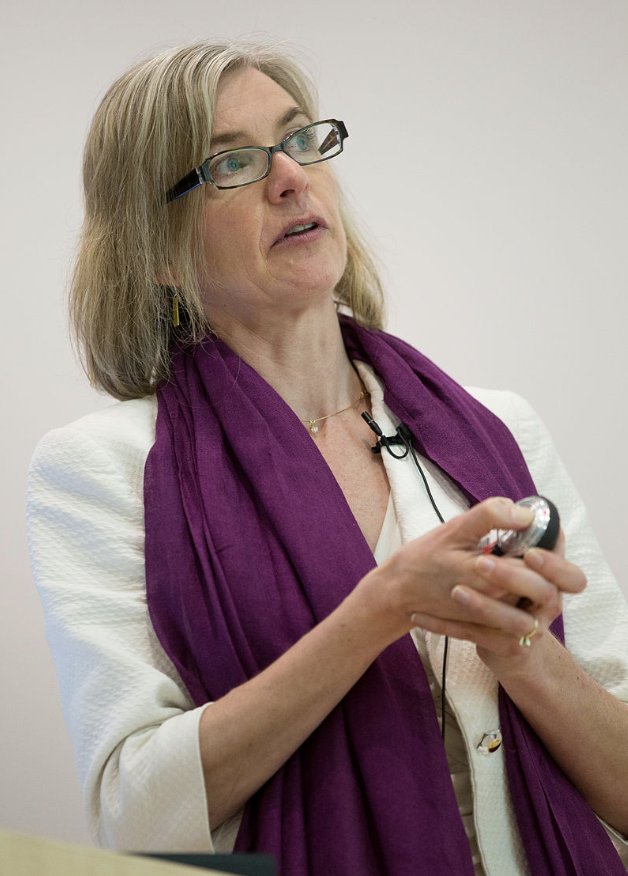Are you familiar with CRISPr gene-editing technology? It’s been called the discovery of the century, but it’s not well known yet outside of science circles. From time to time I’m going to write here about what’s going on with it.
At ScienceNews.org, they talk about it this way:
Scientists usually shy away from using the word miracle — unless they’re talking about the gene-editing tool called CRISPR/Cas9. “You can do anything with CRISPR,” some say. Others just call it amazing.
An interesting fact: Dr. Jennifer Doudna, credited with discovering this technology and one of Time magazine’s 100 most influential people in the world, graduated from Hilo High.
She and a colleague “helped make one of the most monumental discoveries in biology: a relatively easy way to alter any organism’s DNA, just as a computer user can edit a word in a document,” according to The New York Times. People are saying she may get a Nobel Prize for Chemistry for it.
The New York Times article also states:
The discovery has turned Dr. Doudna (the first syllable rhymes with loud) into a celebrity of sorts, the recipient of numerous accolades and prizes. The so-called Crispr-Cas9 genome editing technique is already widely used in laboratory studies, and scientists hope it may one day help rewrite flawed genes in people, opening tremendous new possibilities for treating, even curing, diseases.
But what is it? In an article called “Everything You Need to Know About CRISPR, the New Tool that Edits DNA,” Gizmodo writes:
CRISPR, a new genome editing tool, could transform the field of biology—and a recent study on genetically-engineered human embryos has converted this promise into media hype. But scientists have been tinkering with genomes for decades. Why is CRISPR suddenly such a big deal?
The short answer is that CRISPR allows scientists to edit genomes with unprecedented precision, efficiency, and flexibility. The past few years have seen a flurry of “firsts” with CRISPR, from creating monkeys with targeted mutations to preventing HIV infection in human cells. Earlier this month, Chinese scientists announced they applied the technique to nonviable human embryos, hinting at CRISPR’s potential to cure any genetic disease. And yes, it might even lead to designer babies. (Though, as the results of that study show, it’s still far from ready for the doctor’s office.)
In short, CRISPR is far better than older techniques for gene splicing and editing. And you know what? Scientists didn’t invent it.
CRISPR/Cas9 comes from strep bacteria…
CRISPR is actually a naturally-occurring, ancient defense mechanism found in a wide range of bacteria. As far as back the 1980s, scientists observed a strange pattern in some bacterial genomes. One DNA sequence would be repeated over and over again, with unique sequences in between the repeats. They called this odd configuration “clustered regularly interspaced short palindromic repeats,” or CRISPR.
This was all puzzling until scientists realized the unique sequences in between the repeats matched the DNA of viruses—specifically viruses that prey on bacteria. It turns out CRISPR is one part of the bacteria’s immune system, which keeps bits of dangerous viruses around so it can recognize and defend against those viruses next time they attack. The second part of the defense mechanism is a set of enzymes called Cas (CRISPR-associated proteins), which can precisely snip DNA and slice the hell out of invading viruses. Conveniently, the genes that encode for Cas are always sitting somewhere near the CRISPR sequences….
Although the technology is not without controversy, it is a very interesting subject. It’s going to be huge. I’m following the topic and will occasionally write about it here.


Perhaps this will be a way to combat the Panama fungus strain that is now threatening the world’s banana crops? Let’s hope that this will be a viable application for the genome editing technique.
Being a former banana grower, I thought that myself. It’s a large threat hanging over the banana industry.
Those are gorgeous bananas in back of the jeep Richard, very appropriate for the wonderful post. I am mightily impressed that CRISPR/Cas discoverer Jenn Doudna is Hilo-aina. S. pyogenes is one of my favorite bacterial pathogens but I never imagined what a secret it held. With the genome of several bananas already known, the modification you propose is readily doable if we understand the virulence factors of the fungi … also in the news at link – http://phys.org/news/2016-08-sequencing-fungal-disease-genomes-banana.html , perhaps by adding an extra chromosome that contains the required CRISPR surveillance and DNAase, along with a short RNA to serve what would otherwise be an anamnestic memorybank like we have in our T-cells. But here’s one catch, antibiotics resulted in resistance genes, so would this approach also generate resistant fungi? Curbing the asexual process of taking suckers to propagate Musa might be a strong complementary approach, putting sex back into bananas! They’d love it. Kal “Keiki” La